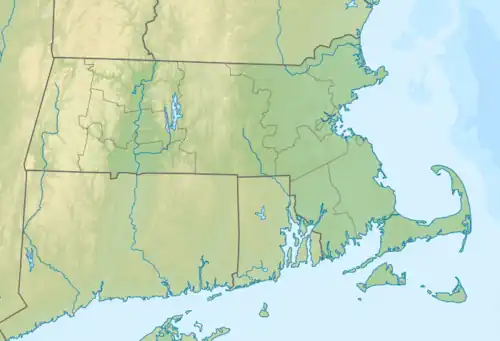| Portland Formation | |
|---|---|
| Stratigraphic range: Hettangian-Sinemurian ~ | |
| Type | Geological formation |
| Unit of | Newark Supergroup |
| Sub-units | Turners Falls Sandstone & Mount Toby Formation |
| Lithology | |
| Primary | Sandstone |
| Other | Mudstone, siltstone, limestone |
| Location | |
| Coordinates | 42°18′N 72°30′W / 42.3°N 72.5°W |
| Approximate paleocoordinates | 24°00′N 18°36′W / 24.0°N 18.6°W |
| Region | Connecticut, Massachusetts |
| Country | |
| Extent | Deerfield & Hartford Basins |
 Portland Formation (the United States)  Portland Formation (Massachusetts) | |
The Portland Formation is a geological formation in Connecticut and Massachusetts in the northeastern United States.[1] It dates back to the Early Jurassic period.[2] The formation consists mainly of sandstone laid down by a series of lakes (in the older half of the formation) and the floodplain of a river (in the younger half). The sedimentary rock layers representing the entire Portland Formation are over 4 kilometres (2.5 mi) thick and were formed over about 4 million years of time, from the Hettangian age (lower half) to the late Hettangian and Sinemurian ages (upper half).[3]
In 2016, the paleontologist Robert E. Weems and colleagues suggested the Portland Formation should be elevated to a geological group within the Newark Supergroup (as the Portland Group), and thereby replacing the former name "Agawam Group". They also reinstated the Longmeadow Sandstone as a formation (within the uppermost Portland Group); it had earlier been considered identical to the Portland Formation.[4]
Vertebrate paleofauna
Dinosaur coprolites are located in Massachusetts, USA.[2] Ornithischian tracks, Theropod tracks and Sauropodomorph tracks are located in Massachusetts and Connecticut, USA.[2]
| Dinosaurs | ||||||
|---|---|---|---|---|---|---|
| Genus | Species | Location | Stratigraphic position | Material | Notes | Images |
| Anchisaurus[2] | A. polyzelus[2] |  | ||||
| Podokesaurus[2] | P. holyokensis | Massachusetts | Partial postcranial skeleton.[5] | All known remains of this species have been destroyed. |  | |
| Neotheropoda sp.[6] | Massachusetts | Partial humerus. | Estimated to have been 9 meters long. | |||
| Non-Dinosaur Archosaurs | ||||||
|---|---|---|---|---|---|---|
| Genus | Species | Location | Stratigraphic position | Material | Notes | Images |
| Stegomosuchus[7] | S. longipes | Hine's Quarry, Longmeadow | Partial postcranial skeleton. | Originally Stegomus. | _(18125938496).jpg.webp) | |
| Pterosauria sp. [8] | South Hadley, Massachusetts | Partial Wrist and tooth. | Non-pteradactyloid pterosaur estimated to have a wingspan of 40cm. | |||
See also
References
- ↑ Portland Formation - USGS
- 1 2 3 4 5 6 7 8 Weishampel et al., 2004, pp.530–532
- ↑ Olsen, P.E. (2002). "Stratigraphy and Age of the Early Jurassic Portland Formation of Connecticut and Massachusetts: A Contribution to the Time Scale of the Early Jurassic". Geological Society of America (Abstract). Archived from the original on 2018-11-28. Retrieved 2017-07-07.
- ↑ Weems, R. E.; Tanner, L. H.; Lucas, S. G. (2016). "Synthesis and revision of the lithostratigraphic groups and formations in the Upper Permian?–Lower Jurassic Newark Supergroup of eastern North America". Stratigraphy. 13 (2): 111–153.
- ↑ "Table 3.1," in Weishampel et al., 2004, p.48
- ↑ McMenamin, M. (2021). Large neotheropod from the Lower Jurassic of Massachusetts. AcademiaLetters, Article 3591. doi:10.20935/AL3591.1©2021 by the author — Open Access — Distributed under CC BY 4.0
- ↑ von Huene, Friedrich (1922). "The Triassic reptilian order Thecodontia". American Journal of Science. 4 (19): 22–26. Bibcode:1922AmJS....4...22H. doi:10.2475/ajs.s5-4.19.22.
- ↑ https://www.researchgate.net/publication/355340350_Early_Jurassic_pterosaur_from_Massachusetts
Bibliography
- Weishampel, David B.; Dodson, Peter; Osmólska, Halszka, eds. (2004). The Dinosauria, 2nd edition. Berkeley: University of California Press. ISBN 0-520-24209-2. Retrieved 2019-02-21.